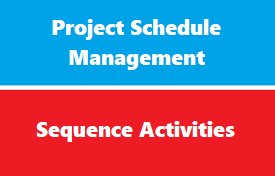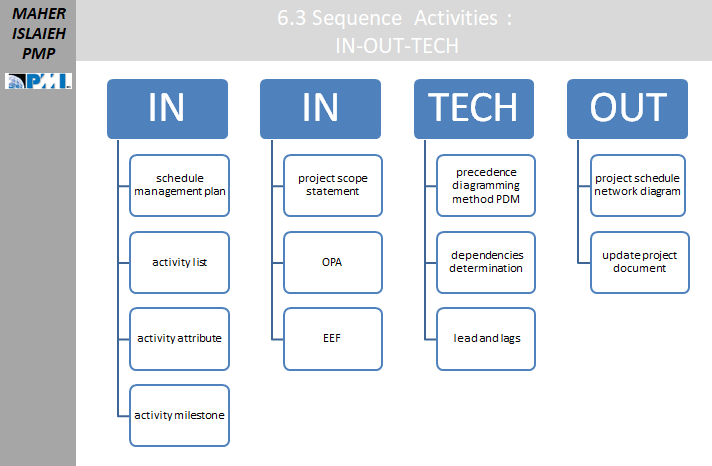introduction
Sequence Activities is the process of identifying and documenting relationships among the project activities.
The key benefit of this process is that it defines the logical sequence of work to obtain the greatest efficiency given all project constraints.
Sequence Activities : Schedule Network Diagram
the main benefit of sequence activity is (schedule Network Diagram )
A network diagram does help you track flow, but it should be the flow of the work, not information. The network diagram has nothing to do with cost or reward systems. The network diagram helps you know when work on the project should be done and in what order
Diagramming Methods
Diagramming Methods
in past there was many draw diagramming methods like :
ADM
Arrow Diagramming Method
GERT
Graphic Evaluation and Review Technique : allow loop from successor to precedence
PDM
Precedence Diagramming Methods :also called AON Activity On Node, (which is used today ), Has Four Type of logical relation s:
- Finish-to-Start
- Finish-to-Finish
- Start-to-Start
- Start-to-Finish
Finish-to-Start (FS)
- In this relationship, task B cannot start until task A finishes.
- This is the most common scenario and in the absence of any other criteria, all tasks could have this dependency in order to produce a functioning schedule.
Finish-to-Finish (FF)
- In this relationship, task B cannot finish until task A finishes.
Start-to-Start
- In this relationship, task B cannot start until task A starts.
Start-to-Finish
- In this relationship, task B cannot finish until task A starts.
- This is a rare relationship but it happens:
please note : Each task should have two relationships:
- Predecessor with an FS or SS relationship.
- Successor with an FS or FF relationship.
Type of Dependences
Type of Dependences
- hard relationship (MUST , mandatory) : like the nature of work being done
- discretionary (optional) : like experience , useful to compress schedule
- external (outside project) like to need someone outside the project
- internal : based on something that team can control
sequence activities inputs-tools-techniques-outputs
Inputs
- schedule management plan
- activity list
- activity attribute
- activity milestone
- project scope statement
- OPA
- EEF
Techniques
- precedence diagramming method PDM
- dependencies determination
- lead and lags
Outputs
- project schedule network diagram
- update project document
Sequence Activities; Inputs
Project Management Plan
The two components of the project management plan used in this process are:
1- Scope management plan
- this is the knowledge area management plan that covers scope management, in particular
- the scheduling methodology (for example, Critical Path Method) and
- the scheduling tool (for example, Microsoft Project) to be used in developing the project schedule model are specified.
- When PMI talks about the project schedule model, just think of the project schedule. The word “model” is added by PMI to make sure you know that it is not written in stone: it may change if the assumptions that created it change based on newly discovered or recently changed information about the project.
2- Scope baseline
- this actually consists of three separate documents, the
- Project scope statement, which has the scope broken down from the level of requirements to the deliverables that will fulfill those requirements
- WBS–the work breakdown structure, with the scope of the deliverables further broken down into manageable parts called work packages.
- WBS dictionary–this contains information about the work packages, for example, who will do the work, what resources are needed, etc.
Project Documents
Project documents used as inputs are mostly those that are outputs of the previous process, but may also include documents that were created way back when the project charter was created (assumption log).
- Activities list–all activities needed for the project, based on the decomposition process done on the work packages during the 6.2 Define Activities project. These are to be sequenced in the upcoming process.
- Activity attributes–information about the activities (most of this will be developed during the upcoming process, but to be included if any of this information is already known)
- any clearly defined predecessor or successor relationships among activities
- any specified leads or lags between activities
- any specified logical relationships between activities (does the successor activity need to start before or after the predecessor activity ends, for example)
- Milestone list–milestones can be specified as early as the project charter, but can also be made specific as a result of the last process
- Assumption log–can be created as early as the project charter; these assumptions may influence the way the activities are sequenced.
Enterprise Environmental Factors
- Project management information system (PMIS) and/or scheduling tools–note that PMI considers that the software is an enterprise environmental factor, but documents created by the organization using the software are in fact part of the organizational process assets (see next section)
- Organization work authorization systems (for each activity, does there need to be authorization at a certain level for work to go forward?)
- Government or industry standards, particularly if the current project is similar to ones done before in the industry
Organizational Process Assets
- Templates to be used for creating a network of the project activities during the upcoming process (should be included as part of Scope Management Plan)
- Policies, procedures and/or guidelines for developing logical relationships between activities (should be included as part of Scope Management Plan)
- Lessons learned repository–if there have been similar previous projects done by the organization, this can help with the process of sequencing the activities in the current project
Sequence Activities: Tools and Techniques
Precedence Diagramming Method (PDM)
Explained above
Dependency Determination and Integration
Explained above
Leads and Lags
- lead is the amount of time a successor activity can be advanced with respect to a predecessor activity. A two-week lead for a successor activity would mean that it could be started two weeks prior to the completion of the predecessor activity.
- lag is the amount of time a successor activity can be delayed with respect to a predecessor activity. A two-week delay lag for a successor activity would mean that it could only be started two weeks after the completion of the predecessor activity.
Simply,,,
- lead :indicate that activity could start before predecessor activity finished,, and represented in MS project with negative value
- lag :delay start activity with mount of days (or weeks, months) , which represented at MS project with positive value
Project Management Information System (PMIS)
This is the scheduling software that you use to help sequence the activities (such as Microsoft Project or Primavera which fully covered in separate course in networks pioneers ).
Sequence Activities: Outputs
Project Schedule Network Diagram
This is a diagram that looks like a flowchart; it graphically represents the logical relationships between activities by having lines and arrows connecting the activities represented by rectangular boxes called nodes.
Project Document Updates
1 Activity List
- The activity list is the result of the technique of decomposition applied to the work packages of the WBS.
- The work packages are things, tangible or otherwise, and so are nouns, whereas activities are the work required to completed those work packages, and so are verbs.
- The activities list was created as an output to process 6.2 Define Activities.
- The associated list of activity attributes may be updated as an output of this process.
2 Activity Attributes
Activity attributes are associated with each activity in the activity list; the activity attributes that may be added after this process include:
- any activities that describe a necessary sequence (mandatory dependencies)
- defined predecessor/successor relationships among activities (usually FS or “Finish-to-Start if otherwise unspecified; any unusual activity sequences such as SS “Start-to-Start” or FF “Finish-to-Finish” should be specified)
- defined leads or lags between activities
3 Assumption Log
- The assumptions and constraints that affect the project schedule (some of which may have been stated way back in the project charter) may be impacted by changes in the relationships between activities specified during this process. (For example, mandatory dependencies cannot be altered as opposed to discretionary dependencies, and internal dependencies can be altered more easily as opposed to external dependencies.)
4 Milestone Log
- Some of the specified dates for specific milestones on the project may be impacted by changes in the relationships between activities specified during this process.
- Now that we know the SEQUENCE in which the activities will take, the next thing we have to determine in order to create the schedule is an estimate of the DURATION of these activities.
- That is the next process 6.4 Estimate Activity Durations and is the subject of the next post.



